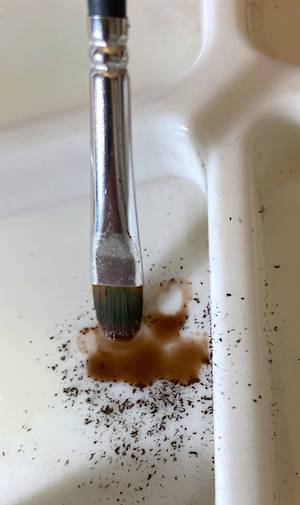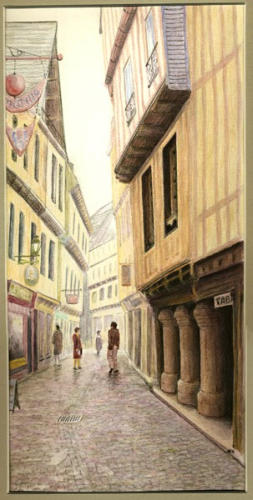- Home
- Watercolor Pencils
- Watercolour brushes
Watercolour brushes
for watercolour pencils
Watercolour brushes are the unsung heroes of the watercolour pencil world. They help blend the colors, soften the edges, and add vibrant colour to your dry artwork.
Not only do these brushes allow for more precision and control, but they also enable you to create a wide range of exciting effects and textures. As soon as you touch the brush to the pigment it brings your drawing to life! You could say that the pencil and brush are a dynamic duo!
The key to becoming a successful watercolour pencil artist is not just about learning how to use the pencils but also understanding how watercolour brushes can enhance your work.
They come in a variety of shapes and sizes, each with its own unique characteristics and functionalities.
Now, you might be wondering, "How do I choose the right brush for my watercolour pencil art?"
Well that's where this guide comes in. Whether you're a seasoned artist or a newbie, it's essential to familiarise yourself with different brushes and their uses to maximise your art's potential.
Choosing between sable or synthetic watercolour brushes
So how do you decide between expensive sable brushes or more affordable synthetic versions?
Watercolour artists treasure their sable brushes. They're made from high-quality animal hair, hold copious amounts of water and have a fine tip that springs back to shape.
However, despite their luxurious quality, sable brushes come at a hefty price. If you are on a budget or new to the medium, you might find your heart sinking as you stare at the price tags.
This is where synthetic brushes for watercolour pencils come in, offering a cost-effective alternative without compromising on performance.
Made from man-made filaments, they can do almost everything that real animal hair brushes can do.
The job of your brush is to moisten, move, blend and lift. These all have a 'scrubbing' effect with the brush tip and therefore a quality brush would soon be ruined. Once your brush starts to lose the point, throw it away and replace it.
Synthetic brushes don't hold a lot of water, (unlike sable brushes) but you can control how much you put on your paper. This makes them ideal for creating gentle washes of color or adding intricate details to your artwork.

In the photograph, the two sable watercolour brushes on the right were ruined before I discovered nylon brushes. They should have the lovely points shown on the middle three. The three on the left are the ones I am more likely to reach for now.
Choosing the right brush to accompany your watercolour pencils does not have to be a source of frustration, but an exciting part of creative discovery.
Think of it like finding a new friend. You've got to meet a few to see who you click with.
Try out different brushes and see how they feel when you paint.
- Are they comfortable to hold?
- Do they spread the colour the way you like?
Take your time and enjoy the process. You'll know you've found 'the one' when it just feels right, and your painting flows just how you imagined.
It's all part of the fun and excitement of being an artist, discovering new things along the way.
Watercolour brushes come in different shapes and sizes
Round brushes are a staple for every artist's toolbox. They are perfect for detailed work, and their shape allows you to create thin lines with the tip and broader strokes with the body of the brush.
Flat brushes have a square end and are superb for filling in larger areas swiftly. From creating large washes to producing sharp-edged shapes, flat brushes are a versatile addition for your watercolour pencil work.

Filbert brushes, (shown in the photo above) with their flat, oval shape are excellent for providing a softer, rounder edge that’s ideal for blending, thus bringing balance to your art.
If you love paying attention to tiny details, liner brushes (also called rigger brushes) with their long thin bristles help you make precise lines. Of course you could just use the dry pencils for these, but the brush offers a different mark making technique.
Don’t forget fan brushes which may look unusual, but can be used creatively to make cool textures with watercolour pencils.
Finding the perfect brush can take some time and experimentation, as I mentioned above.
Another Alternative
What if you want to create art when out and about?
Hauling around an entire set of pencils, brushes and a water pot can be a hassle. Is there an easier way? Absolutely! Enter the waterbrush.
This isn't your everyday brush. It's specially created for outdoor or on-location painting sessions—what artists call 'plein air' painting. But why is it so special?
A push button waterbrush combines the ethos of a traditional paintbrush with the built-in water supply of a fountain pen. It is designed with a water reservoir in its handle, which allows for easy water dispersion to the bristles simply by pushing a button
It offers you control over the flow of water, unlike other waterbrushes where gravity does the work. You can fine-tune the release of water with a simple push, facilitating control over the wetness of your brush, the blending, and dilution of colours.
While the waterbrush provides multiple benefits and conveniences for plein air painting, it is equally proficient for studio artwork. Paired with watercolour pencils they offer a highly portable, adaptable, and enjoyable painting solution.
These compact, portable brushes have revolutionised the art world.
How to use watercolour brushes
Now, let's talk technique. Begin by lightly sketching your subject with the watercolour pencils. Remember, less is more at this stage; you can always add more color later.
Once you're happy with your sketch, dip your brush in water and gently dab it on a paper towel. You want it damp but not dripping – we're painting, not going for a swim!
Start by activating the pencil lines with your damp brush. Work in small sections, blending the colours as you go.
This is where the magic happens – as you brush over the pencil, the pigment starts to activate, creating that beautiful watercolour effect. Gentle strokes will allow the colors to mingle on the page, creating soft gradients and subtle shifts that give your artwork depth and life.
Experiment with different strokes and amounts of water to see how they affect the pigment. Play around with it – art is a process of discovery, after all. You might find that a little more water creates a dreamier, more ethereal effect, while less water keeps the colours vibrant.

Using a stiff watercolour brush, it is possible to work large areas of paint by lifting and moving the pigment around on the paper.
If you push the brush across the paper the pigment will build up in front of the brush just like snow would in advance of a snowplough. This leaves a lighter area behind the brush as the pigment moves forward.
If you drag the brush you will eventually run out of pigment and the end of your stroke will be lighter in value.
By working these motions together, you can build up areas of colour that vary in tone. Peter used this technique to create the cobbles in the art shown in the photograph.
But what if you go overboard? Don't panic, most watercolour pencils are forgiving and the color can be lifted by applying more water and dabbing with a paper towel. I say most, because this technique will not work with Derwent Inktense pencils, which contain ink rather than pigment.
As you get more comfortable with the brush, start to play with different watercolour pencil techniques. Try shading with the side of the pencil to cover larger areas, or use a sharp point for intricate details. Then use the brush to gently blend the colours together, watching as they bleed into one another.
Wrapping up
To wrap it up, using a watercolour brush with watercolour pencils is all about experimentation, a light touch, and embracing the fluidity of the medium. It's an art form that combines the control of drawing with the spontaneity of painting, and the results can be truly stunning.
So go ahead, give it a whirl. With these tips in hand, you're ready to bridge the gap between pencil and paint.
And remember, every famous artist was once a beginner. Your watercolour pencil journey starts with a single brushstroke.




